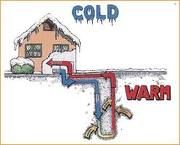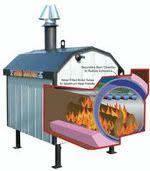The Chilling Cost of Keeping Warm – part 2: Options?
 In the first part of this article, I discussed the cost of heating our house with wood or oil through the Maritime winter. But we have other spaces that require heating too.
In the first part of this article, I discussed the cost of heating our house with wood or oil through the Maritime winter. But we have other spaces that require heating too.
When we moved here, we renovated part of the large garage/barn on our property into my husband’s home office, and a hobbies room. Both are fairly high ceilinged, and represent about 700 square feet of living space. It’s necessary to keep at least the hobby room heated at all times. Since the building is a short city block from the house, it wasn’t feasible to install a wood burning stove out there, since we wouldn’t be available every day or night to tend it, and heat needed to be constant. So we installed electric baseboard heaters.
Keeping the temperature about 65 degrees F (about 18C) costs us about $250 per month in the coldest winter months. That wouldn’t be so onerous if it was our main heating space, but add it to the cost of heating the house (and the added granny flat/visitors’ suite that is also heated with electricity) and we’re looking at a desperate situation.
What are our options?
1) Geo-thermal heating. Geothermal heat pumps use heat from the ground to heat the home. This would be the ideal system since one installation could heat both buildings at a very low cost and with almost zero impact on the environment.
However, since geothermal heat pumps are considerably more efficient than air-source heat pumps, they are also more expensive to purchase and install. To have an adequate system installed here would cost us about $30,000.
2) An outdoor wood furnace or wood boiler system. These heat water by burning wood very efficiently and can tie in to existing hot water baseboards, forced air, or in floor heating. This unit could also possibly heat both buildings and has the advantage of needing to be fed only once every 12 hours or so. In addition, the firewood pieces can be much larger than what would fit into a wood stove (or even the basement wood furnace) and would save on chopping/splitting – either in time or money.
These heat water by burning wood very efficiently and can tie in to existing hot water baseboards, forced air, or in floor heating. This unit could also possibly heat both buildings and has the advantage of needing to be fed only once every 12 hours or so. In addition, the firewood pieces can be much larger than what would fit into a wood stove (or even the basement wood furnace) and would save on chopping/splitting – either in time or money.
To heat the outbuilding, though, would require installation of ducting and so the cost of installing one of these would be about $12,000.
3) An indoor wood stove on the main floor. This would seem a quick and easy solution except for the fact that we can’t use our existing chimney for it because of the oil-burning backup unit in the basement. (Insurance regulations prohibit a wood burning device above an oil-burning device on the same chimney.) We would have to install another chimney and also take down some inside walls on the main floor to allow for better heat circulation. I’m not sure of the cost of all this – renovations, installation of a hearth, the stove purchase and installation and the new chimney, but I’m sure you get the idea…and that doesn’t address heating the rooms in the barn or the suite.
Either wood-burning solution still leaves us vulnerable to the rising cost of firewood and to guilt whenever we see a clear-cut hillside.
4) Wall mounted air-exchange heat pump. Again, this doesn’t help with the heating of the granny flat or the barn, and would require renovations to the inside walls of the house for air flow. Add that to the cost of the pump and installation and we’re likely in the $10,000 range – and we’re not confident that the lay-out of the house would allow adequate heating on the second floor.
As you can see, we must spend money to save money and right now the capital for any of these isn’t available. That was definitely something we overlooked before we bought.
LEARN FROM OUR MISTAKE. Pay attention to the heating system if you’re moving outside the familiar infrastructure of a town or city. And don’t be swayed by the romance of heating with wood.
Do you have any other suggestions we might consider for heating our buildings? I’d love to hear from you.